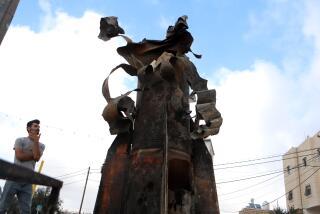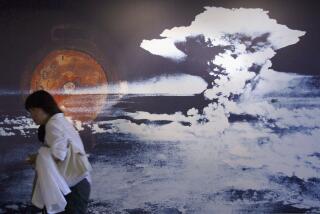Nuclear Specter Haunts Us Still
- Share via
Reality and fiction have coincided in recent weeks to remind Americans that the major nuclear powers still have at their fingertips the ability to destroy life on Earth many times over.
According to a report from the National Academy of Scientists, “significant portions of U.S. and Russian nuclear forces are maintained in a continuous state of alert.” The Cold War may be over but so-called nuclear readiness is not. Though the numbers of nuclear warheads have declined, the two nations still possess thousands of them.
The process of disarmament is complex, politically sensitive and agonizingly slow. Even when the goals of the START II treaty are fulfilled, each nation will have some 3,000 nuclear missiles on hand. The aim of the future START III is to cut that to 2,000 to 2,500. The scientists’ report suggested the arsenals could safely be reduced to 1,000 or fewer on each side. Fear of a first strike could be alleviated by basing the weapons on submarines, it said.
Perhaps the most amazing fact is that so many nuclear weapons--as many as 60,000 at one time--have existed through decades of world tension without a single one being discharged in anger or by accident. But the scientists’ report says that the more weapons that remain, the greater the chance of an accidental or unauthorized launch or of a weapon falling into terrorist hands.
Going even further in appealing for disarmament is Hans A. Bethe, the Nobel Prize-winning physicist, at 90 still active at Columbia University. Bethe directed the theoretical division of the Los Alamos, N.M., laboratory that developed the first atomic bombs. He suggests the two nuclear powers could cut their arsenals to as few as 100 weapons each, and perhaps to none someday.
Reaching zero might seem unrealistic or undesirable now. But aiming for the smallest practical number should remain a constant goal.
Bethe, the senior surviving member of the Los Alamos team headed by the late J. Robert Oppenheimer, also said that he had written President Clinton urging that this nation promise it will not develop any sophisticated new nuclear weapons.
Coincidentally, Bethe appears along with other former German physicists as a minor character in one of this summer’s best-selling novels, “Los Alamos,” a murder-spy thriller set around the making of the first bomb.
At the end, the novel’s protagonist, Michael Connolly, watches the first detonation at Trinity Site in the predawn hours of July 16, 1945. along with Oppenheimer and others. As the horror unfolds, author Joseph Kanon gives Connolly these thoughts: “This was the real secret. Annihilation. Nothing else. . . . Now we would always be frightened.”
In fact, more than 50 years later, perhaps we are not frightened enough.
More to Read
Sign up for our Book Club newsletter
Get the latest news, events and more from the Los Angeles Times Book Club, and help us get L.A. reading and talking.
You may occasionally receive promotional content from the Los Angeles Times.







